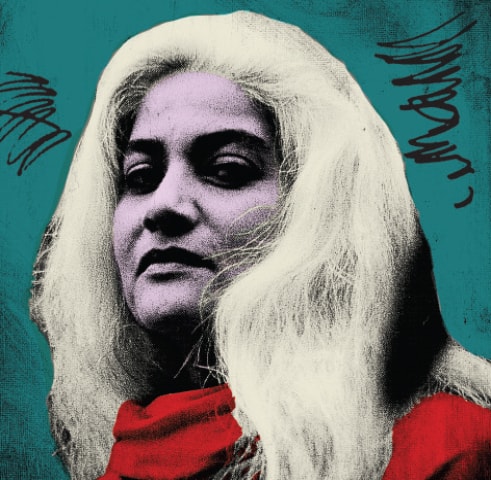
In my quest to discover the origins of the exquisite tiles in my aunt’s home in Karachi’s old settlement Amil Colony, I stumbled upon a whole new dimension of the Swadeshi, and later Swaraj movement, an important rallying point for the freedom movement.
Swaraj is commonly identified with non-cooperation, civil disobedience and political rallies. Behind the public bonfires of European cloth, manufacturers, designers, artists, poets and journalists quietly built factories, established presses, redesigned art school curricula that not only spread the spirit of revolution across India, but ensured there were locally produced alternatives.
Jamshed Nusserwanji established Bharat Tiles with Pheroze Sidhwa in 1922 in Bombay with a manufacturing branch in Karachi, as his Swadeshi contribution, saying, “India needs both economic and political independence.” Developing a new process using coloured cements, the exquisite tiles we see in all heritage buildings in South Asia replaced the competition by Minton Tiles of Stoke on Trent, England. Stamped on the back of every tile, was a map of India.
Fifty years earlier, the Parsi statesman Dadabhai Naoroji (1825-1917) laid the foundations for Home Rule by raising the question of the drain of wealth from India to England in the British parliament. He opened, for the first time, a branch of an Indian company in Britain and established in 1867 the East India Association to put across the Indian point of view before the British public. The association successfully countered the propaganda that Asians were inferior to Europeans and soon became an influential voice in the British Parliament. Naoroji published Poverty and un-British Rule in India in 1901. He worked side by side with Jinnah, Tilak, Gokhale and Gandhi.
The dissolution by the British of the Mughal art karkhanas (factories) sent court artists to the palaces of Nawabs and Maharajas where new art forms emerged incorporating local styles.
The attempt to partition Bengal in 1905 gave rise to the first Swadeshi movement. Soon, local manufacture of bicycles, matches, fans, paper mills, fabrics and a host of everyday products began proudly displaying nationalist slogans: ‘Buy Swadeshi’, ‘India’s Pride Nation’s Wealth’, ‘Boycott Foreign Goods.’ Pakistan’s famous Tibet products of Kohinoor Chemicals grew out of this Swadeshi movement.
The freedom movement is usually defined as a Hindu/Muslim effort. However, along with Parsis many Christians played an important role in the 1930s and 1940s including J.J. Cornelius, Paul Ramasamy, Anne Mascarenes, Joachim Alva and others. Lal Din Sharaf formed the Pakistan Masih League in 1945, the minority wing of the Pakistan Muslim League. The All India Christian Conference, along with other minorities, also rejected the Nehru Report, supporting Jinnah’s stance. Homai Vyarawalla, India’s first female (and Parsi) photojournalist and Lahore’s Faustin Elmer Chaudhry documented the movement from the Indian perspective. Pakistan’s national anthem composed by A.K. Chagla was set to orchestra by Tollentine Fonseca.
The dissolution by the British of the Mughal art karkhanas (factories) sent court artists to the palaces of nawabs and maharajas where new art forms emerged, incorporating local styles. The 19th century Kalighat caricature-style paintings were already a voice of dissension. The conscious decision to reclaim art in the service of nationalism grew with the Bengal Art Movement in Calcutta. Although supported by an Englishman, E.B. Havell, artists led by the poet Rabindranath Tagore and his artist nephew, Abanindranath, turned to traditional canons of art.
Tagore’s Shantiniketin School became very influential with branches in many cities including the Saranagati building at Pakistan Chowk in Karachi, where Sughra Rababi first trained. Tagore’s paintings depicting ‘Bharat Mata’ (1905) and ‘The Last Hours of Shah Jahan’ (1902) and A.R. Chughtai’s romanticised oriental imagery and Jamini Roy’s folk art became icons of the movement. Artist Fyzee Rahamin, renounced his Western portraiture in the 1920s in the wake of Gandhi’s nationalist movement. Nandalal Bose and his pupils at Shantiniketan were selected by Gandhi to decorate the Haripura Congress enclosure in 1937.
Bose’s 1930 linocut print of Gandhi on his salt march, Ravi Varma’s ‘Sarswati’ ( 1896), Amrita Sher-Gill’s ‘Three Girls’ ( 1935) and Zainul Abideen’s ‘Bengal Famine Series’ (1943) were as much political as artistic statements. Ananda Coomeraswamy’s publications of extensively researched local aesthetics are still of great importance. The art historian Partha Mitter writes, “The extremist political leader, Aurobindo Ghose, deemed art important enough to be brought into his political programme.”
The Indian People’s Theatre Association, formed in 1943, used music and theatre to awaken the common man. Songs became an important medium to express patriotism — best known being the Vande Mataram and Iqbal’s Tarana-i-Hind, ‘Sare jahan se achha Hindustan hamara.’ Cinema, too, played its role. The popular song from the film Kismat (1943), ‘Door hato aye duniya walo hindustan hamara hai,’ was written and sung by a freedom fighter, Kavi Pradeep. Poetry and song united farmer and landlord, the educated and the illiterate, as well as cities and villages.
Hasrat Mohani’s Inqilab Zindabad became Bhagat Singh’s slogan. The political poetry of Shibli, Iqbal, Josh, Jauhar and countless others, in almost every language of India, directly impacted the freedom movement. Poems were recited in prison, at rallies, published in revolutionary newspapers and even recited on the gallows.
The new printing presses allowed poetry and books to be published and shared and gave rise to newspapers and journalism. A vibrant nationalist press emerged from 1870 onwards, despite press acts to restrict anti-British writings. Fearless writers faced imprisonment and confiscation of presses, only to continue upon their release. The names of newspapers — Comrade, Hamdard, Young India, Bandemataram, Inqilab and Dawn — were themselves a message of revolution.
The expansion of the freedom movement was only possible by first undermining the absolute cultural authority of the British, by reviving pride in all things local from the charkha to indigenous languages and traditions.
Durriya Kazi is a Karachi-based artist and heads the department of visual studies at the University of Karachi
Published in Dawn, EOS, May 20th, 2018














































